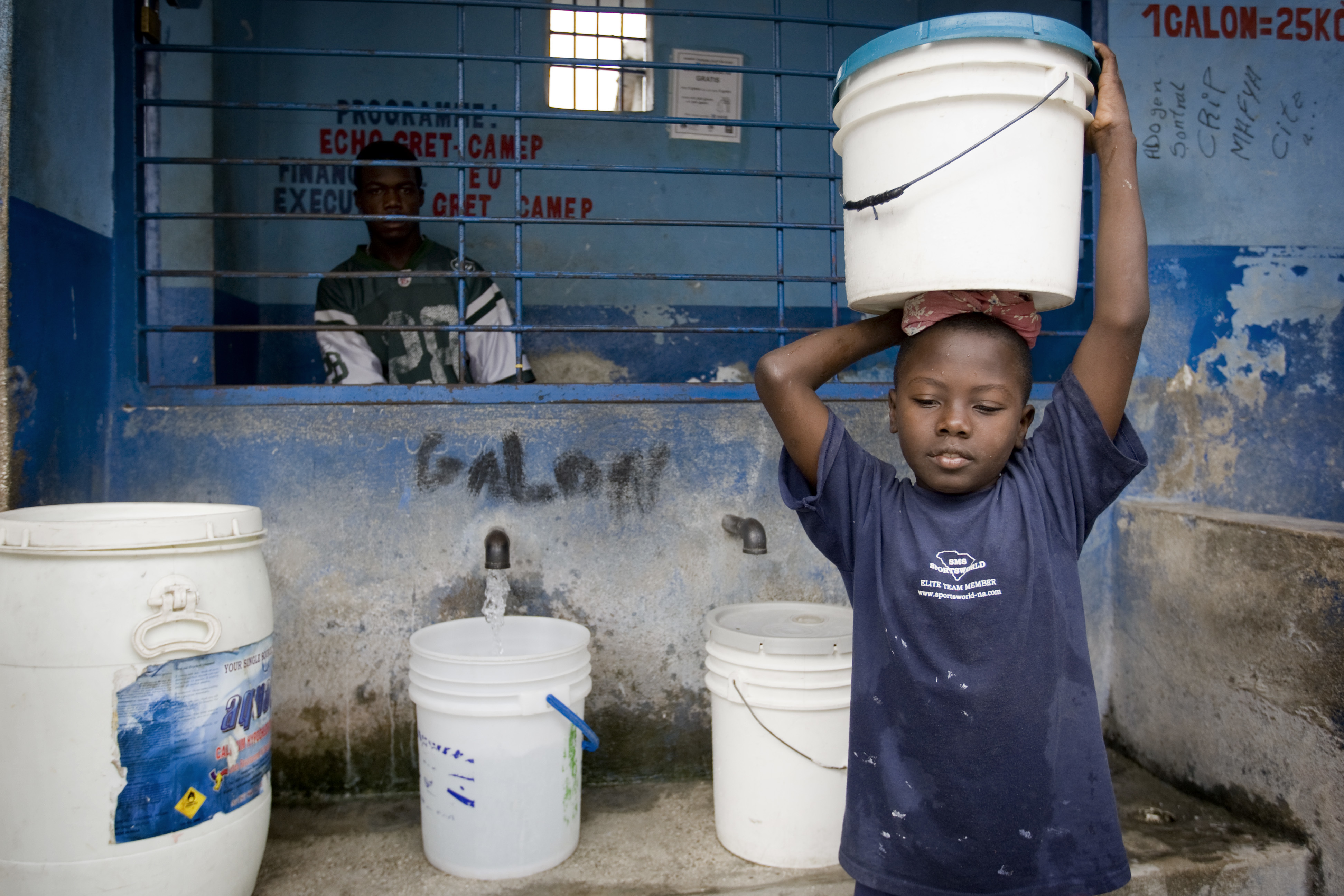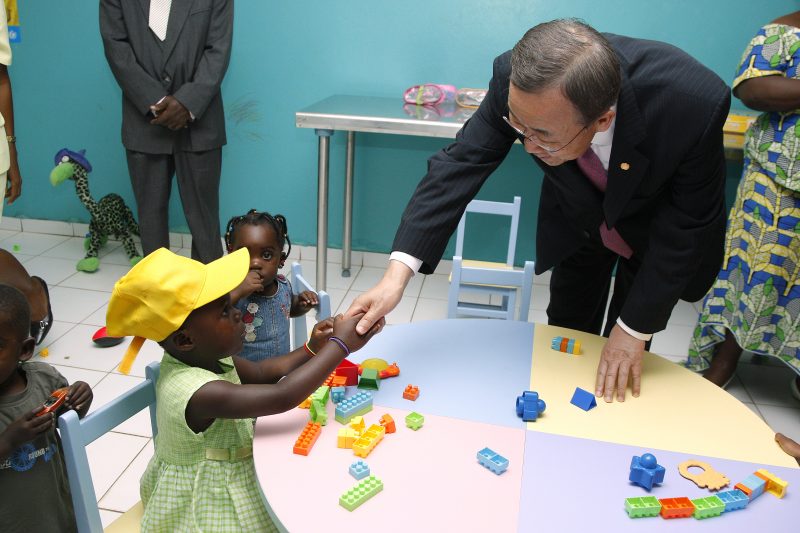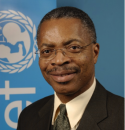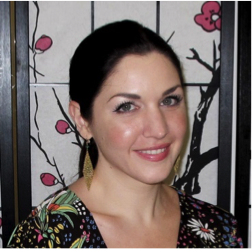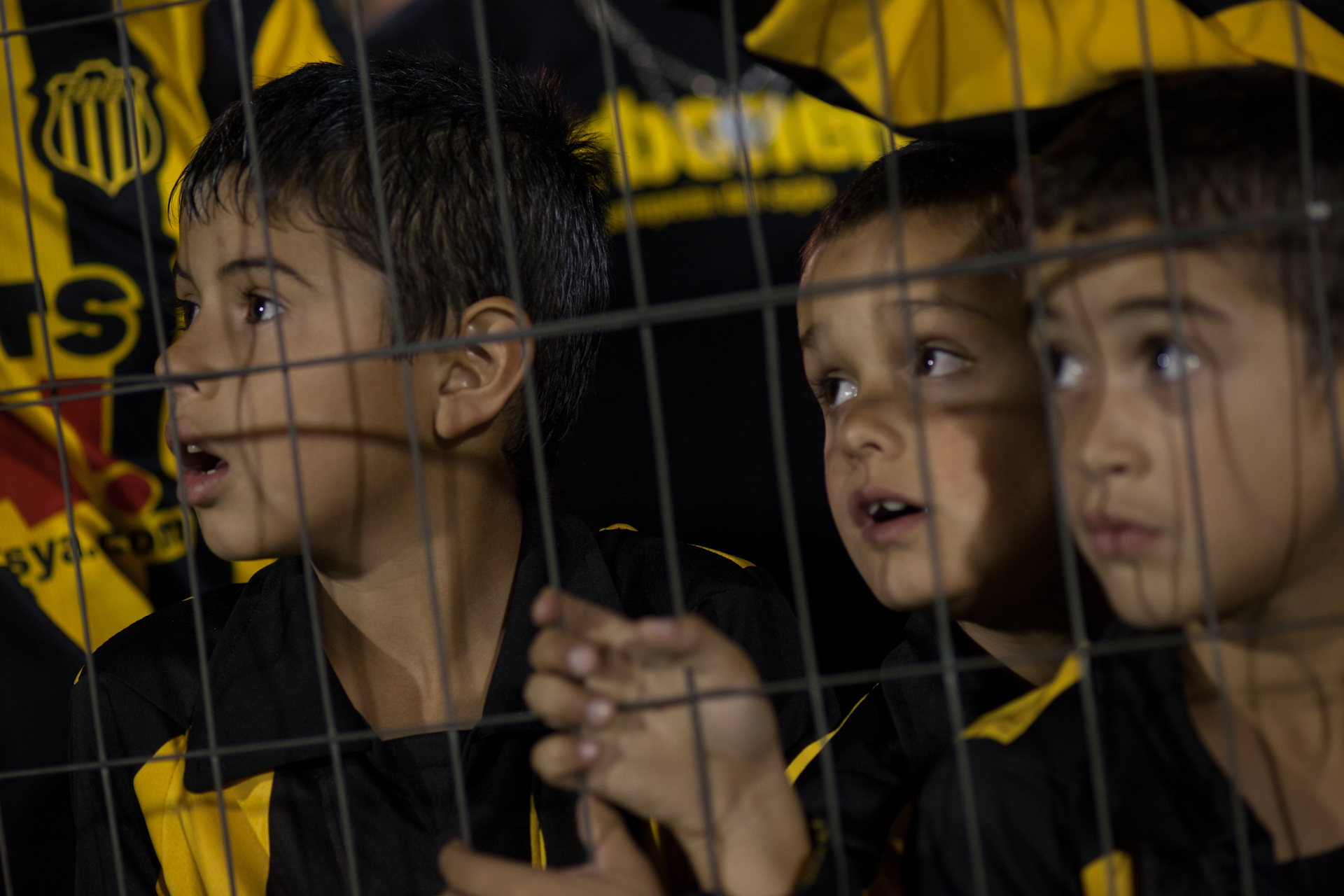EDITOR’S NOTE: THIS PIECE IS AUTHORED BY NICHOLAS ALIPUI AND SHANNON O’SHEA, EXPERT ON CHILD HEALTH, DEVELOPMENT AND AGENDA 2030 PROGRAMME SPECIALIST OF UNICEF.THIS PIECE IS PART OF A SERIES EXPLORING THE SUSTAINABLE DEVELOPMENT GOALS. SEE THE INTRODUCTION TO THE SERIES HERE. AN EARLIER VERSION OF THIS ARTICLE WAS PUBLISHED IN SEPTEMBER 2015 IN THE HARVARD INTERNATIONAL REVIEW. THE ARTICLE HAS BEEN UPDATED WITH NEW CONTENT AND EVIDENCE FOR THE PURPOSE OF THIS PUBLICATION.
Introduction—a vision of the future we want in 2030
It is the year 2030, and a child is born in a hospital. Even though her mother experiences complications during the birth, both mother and daughter survive and fully recover. The hospital has properly trained staff and the right medicines and equipment. The hospital never loses power; in fact, it is fully supplied by a reliable and renewable energy source.
The baby and her family are not wealthy, but they have access to the services that they need. She lives in a clean environment, in a home where she is stimulated, cared for, and loved. She is free from violence and toxic stress. As she grows, she learns to use a toilet and wash her hands. She has access to nutritious food and clean water. When the time comes, she is ready to go to school, and she is well-prepared to learn.
In school, the girl’s teachers present her with coursework that challenges her young mind, and she excels. She learns not only to count, read, and write but also acquires skills that will help her throughout her life: financial literacy, vocational skills, tolerance and respect for other people and the planet, and the importance of civic engagement and political participation. Her teachers and peers are a source of inspiration and confidence, and their lessons will stay with her for the rest of her life.
When she enters the workforce, she is paid a livable wage, equal to what a man is paid. She may become a doctor, a tech entrepreneur, a business owner, a teacher, or a farmer: The choice is hers. She will be a positive impact on her community and a contributor to the global economy. She may have a family — or not — and they will have the same, or possibly more, opportunities than she had.
Our child born in 2030 is the living realization of “The Future We Want,” and she, and all children, are the foundation for this future and represent a common basis for all dimensions of sustainable development. However, massive inequalities across the world threaten this vision, leaving millions of children behind and unable to fulfill their full potential. It is only through investing in all children — as well as cultivating their understanding of the issues expressed through the Sustainable Development Goals (SDGs) and inspiring them to take positive action in their own lives and communities — that the global community will succeed in achieving equitable, inclusive, and sustainable development.
Transitioning from the MDGs to the SDGs: What did we learn?
Progress has been tragically uneven, especially in early childhood, which is a crucial stage of human development. Globally, the poorest children are still at significantly higher risk of dying before their fifth birthday, being stunted due to chronic malnutrition, or lacking access to clean water, hygiene and sanitation facilities.
2015 was a watershed year for international development. It marked the end of the Millennium Development Goals (MDGs), a simple yet bold commitment that leaders made at the start of the new millennium to tackle the most pressing issues of the time: reducing poverty, ensuring that more children have access to school and don’t die of preventable causes, and combatting HIV/AIDS and other diseases. It was also the year when the world agreed on a new set of goals through 2030: the SDGs.
The SDGs are more ambitious than the MDGs. They are universal, meaning that they apply equally to all nations and to all people, everywhere in the world. They are also broader in scope, covering the three core dimensions of sustainable development — social, economic, and environmental, underpinned by human rights, peace and security, and the rule of law.
The SDGs were developed in a historically inclusive manner that sought the views and the voices of millions of people from around the world and all walks of life. The SDGs will continue to press forward on the unfinished business of the MDGs — especially in the least developed countries and fragile states, where progress has been the slowest — but also take on new issues not covered by the MDGs, including improved governance and transparency in public institutions, protecting children from violence, combating climate change, promoting responsible consumption and production, and fostering social inclusion through reducing inequality, among others.
Photo Credit: Secretary-General Ban Ki-moon shakes hands with a little girl during his visit to a United Nations Children’s Fund (UNICEF) project site for children in social difficulty, in Libreville, Gabon. Evan Schneider, UN Photo, UN Media Archive
Over the 15 years that was the MDG era, there was remarkable progress on many of those goals. In a 2015 UNICEF report, Progress for Children – Beyond Averages: Learning from the MDGs, the data show that we live in a world where 53 percent fewer children die before their fifth birthday than did in 1990; where the number of people living in absolute poverty has been reduced by 900 million; where HIV/AIDS infection rate of children under 14 has been reduced by 58 percent since 2001; and where the rates of primary school attendance for girls are now equal to boys in many regions across the world.
But as the report also notes, progress has been tragically uneven, especially in early childhood, which is a crucial stage of human development. Globally, the poorest children are still at significantly higher risk of dying before their fifth birthday, being stunted due to chronic malnutrition, or lacking access to clean water, hygiene and sanitation facilities. The quality of early stimulation and education varies dramatically across the world, and those who are poor, minorities, disabled, or live in remote areas often suffer the lifelong consequences of this lack of quality education. Communities affected by conflict and humanitarian crises have seen years of painstaking progress wiped away in mere days or months.
However, it is not only children in the developing world who face such challenges. In 2016, UNICEF’s Innocenti Research Center explored inequalities in child well-being in rich countries and found that gaps in educational achievement, health, and overall life satisfaction were significantly higher in wealthy nations that had greater levels of inequality in their societies. The recent global financial crisis also hit many high income nations particularly hard and has exacerbated these issues. The number of children entering into poverty during the recession is 2.6 million higher than the number that have been able to escape from it since 2008 (6.6 million, as against 4 million), and around 76.5 million children live in poverty in the 41 most affluent countries. In the European Union (EU), 7.5 million young people (almost the population of Switzerland) were identified at “NEET” — meaning not in education, employment, or training. In some of the worst hit European nations, the youth unemployment rate is estimated to be upwards of 50 percent, while at the same time schools are not preparing youth with the skills and knowledge needed to transition to the working world.
Related article: “SDG 1: THE GOAL TO SPARE FUTURE GENERATIONS FROM THE SCOURGE OF POVERTY”
A decade and a half into the new millennium, we stand at a crossroads. There is mainstream recognition that climate change, unsustainable consumption and production practices, and rampant inequalities pose existential threats to the people of the world and the planet we inhabit — but will we choose to follow a path towards sustainable development?
To that end, development can only be truly sustainable if it is built around tackling climate change; fighting for every person to have a fair chance in life to fulfill their full potential; and supporting the well-being and resilience of people affected by conflict or those living in fragile contexts. This is done when people in every part of society internalize the concept of sustainable development — when it is something that they own and cherish because they see the importance and applicability of these practices to their own daily lives and their communities. This process must begin by investing in all people at the start of their lives — when they are children.
Investing in children early and at the right times in their lives: the foundation for stronger societies
Photo Credit: Primary school students in Afghanistan attend a school built by UNICEF in 2008. Payman, UN Photo, UN Media Archive
Human beings are different from many other species, whose offsprings’ development largely takes place in utero. For humans, newborns enter the world completely dependent on their caregivers for nourishment, transport, and security. Our brains and bodies also take many years to fully develop, both in early childhood but also through adolescence. Making investments in the health, education, safety, and well-being of children, therefore, is a longterm game, one that — if done right — will pay future dividends for that child and the society in which that child lives.
The Convention on the Rights of the Child (CRC), the most globally ratified international Convention in existence, provides the normative framework for this argument. Through the CRC, the world made a commitment to all children that it would do everything in its power to protect and promote their human rights to survive and thrive, learn, and grow, to be protected from violence, exploitation, and abuse, and to make their voices heard, and to reach their full potential without discrimination.
However, investing in children is not only a human rights issue but also a profitable endeavor for every country: an investment in the most precious of all global public goods — our present and future humanity. Children are the future workforce and future consumers, inventors, advocates, and guardians of our world. They must be fully equipped not only to harness the opportunities but also to meet the immense challenges that we collectively face. An investment in children is an investment in a society’s economic growth; their cleaner and more sustainable environment; the safety and stability of their communities and countries; the strength of their public institutions; and the vibrancy of their private sector. These issues simply cannot be seen separately.
Children and young people are not just passive recipients of development aid — when we invest in their rights, they grow into the agents of change that are and will make our world better.
The evidence for this argument continues to grow. Research from the Copenhagen Consensus Think Tank has shown that increasing the number of children with access to early education in Africa has a US$33 return on investment for every dollar spent. An Independent Expert Group (IEG) on Global Nutrition has found that prevention of undernutrition in early childhood — for example, through breastfeeding and access to adequate fresh and nutritious food and clean drinking water — leads to hourly earnings that are 20 percent higher and wage rates that are 48 percent higher in addition to individuals who are 33 percent more likely to escape poverty and women who are 10 percent more likely to own their own business. Researchers in the Hague at Erasmus University’s International Institute of Social Studies have found that reducing child deaths by five percent to mothers with low levels of education can result in an almost eight percent increase in GDP per capita ten years later.
A 2015 joint study from ChildFund Alliance and the Overseas Development Institute has also looked at the costs of not protecting children, noting that the global economic impact resulting from the consequences of physical, psychological, and sexual violence against children is as high as US$7 trillion over a lifetime. These are but a few examples that demonstrate how investing in children makes smart, economic sense — and how the consequences of not making that investment can be equally devastating.
Leaving no child behind—why an equity focus is essential
Photo Credit: The guest performers on stage at the 2014 global launch of the UN Children’s Fund (UNICEF) “Imagine Project”, a musical and technological initiative helping to highlight the challenges that children face throughout the world and to raise funds for UNICEF’s work in more than 190 countries and territories. Mark Garten, UN Photo, UN Media Archive
The issue of extreme inequality has garnered much media and public attention especially in the last few years. A report done by OxFam in early 2015 shows that nearly half of the world’s global wealth is concentrated with the top percent of the population. Economists such as Thomas Piketty and Joseph Stiglitz have become bestselling authors by warning of the dangers of rampant inequality for democratic and productive societies. Even the wealthy themselves, like hedge fund manager Paul Tudor Jones II, have acknowledged (in a TED talk) that “higher profit margins do not increase societal wealth. What they actually do is exacerbate income inequality, and that’s not a good thing.” Extreme inequality has been shown to contribute to a variety of societal problems: lower life expectancy, increased violence and crime, drug and alcohol abuse, teenage pregnancy, lower literacy rates, and perhaps even the rise of extremist movements.
It is only through both economic growth and targeted, deliberate social investment that societies can positively evolve and prosper. Countries like the Republic of Korea, Malaysia, and Singapore provide a roadmap for this: Combined economic growth and social investment, particularly in children, has led to broad-based, inclusive, and sustainable economic growth. In contrast, countries who have seen rapid economic growth without social investment continue to experience widespread poverty and its accompanying social problems.
Inequalities do not only manifest themselves through differences in wealth or income; they can be found in every corner of society and have their roots in discrimination, exclusion, and lack of agency based on gender, race, ethnicity, disability status, religious belief, and other factors. By addressing these root causes and prioritizing the most vulnerable and marginalized children first, we will be able to make sustainable progress on breaking the intergenerational cycles of poverty that perpetuate inequalities in people’s opportunities. The most cost-effective way to do this is starting with children, through equity-driven programming and policies that afford children the opportunity to survive, develop, and reach their full potential without discrimination or bias. As noted in a June 2015 UNICEF Executive Board Conference Paper, A Fair Chance for Every Child, “When equitable opportunities produce better outcomes for children such as school completion, delayed childbearing, lower maternal mortality, and better job skills, those results can narrow longer-term equality gaps. Lower levels of inequality, in turn, increase the chances for sustained economic growth and more stable societies, which can fuel continued investments in children and families.”
For a full mindmap containing additional related articles and photos, visit #SDGStories
Conversely, not addressing inequalities today will only lead to greater inequalities and larger problems tomorrow. For example, UNICEF’s Progress for Children Report notes that at current rates of progress and given projected population growth, it is estimated that it would take nearly 100 years to achieve 100 percent secondary education completion for girls from sub-Saharan Africa’s poorest families. Some 68 million more children would die before their fifth birthday mostly from preventable causes between now and 2030, and 120 million children under five years of age would be stunted by 2030.
Understanding the depth of inequalities within a community or country is essential for targeting policies and program interventions for those most vulnerable. The ability to collect, analyze, and use data that can be disaggregated by income, gender, age, race, ethnicity, disability, geographic location, and other social and economic dimensions or characteristics is crucial to measuring progress.
Data collected through traditional survey methods such as household surveys and census data must also be complemented by participatory and real-time data collection methods that allow people to share their perceptions, ideas, and “lived experience” about whether a given law, policy, program, or practice is achieving its desired results on the ground. For example, a national statistics office can track the number of health facilities in a district or region, but a conversation can unveil the barriers that HIV-positive orphans might face in trying to access treatment from the facility without a guardian. Participatory methods provide this “reality check.”
Making sure that all people are included in all aspects of development, fulfills their human right to participation; can give a sense of hope, purpose, and dignity; and can also help to shift harmful attitudes and biases. It can also make programs and initiatives more relevant and effective.
The phrase, “Leave no one behind,” has been adopted by many as the rallying call for the SDGs and the centerpiece for their implementation. For this to have practical meaning beyond words on paper, it must be followed through with resources and initiatives aimed at narrowing equity gaps and reaching the hardest-to-reach first.
Children knowing and understanding their human rights—positive action begins with global awareness
The face of social movements — both positive and negative — is the face of a young person…Channeling a young person’s emotions, energies, and indignation with injustice towards good rather than evil will determine not only the success of the SDGs but also the stability and sustainability of our societies.
One of the hallmarks of the process to craft the SDGs has been the inclusion of various people in the deliberations through global surveys, national and thematic consultations, focus group discussions, and multi-stakeholder dialogues. This inclusiveness should be one of the lasting legacies carried forward in the implementation of the SDGs over the next several years.
Children and youth were two of the most active and passionate constituency groups in this process. They have demanded that issues of importance to them are reflected in the goals but have also made a plea to decision-makers that the SDGs should “provide a platform for young people to channel their infinite activism into helping others all over the globe.” Children and youth know that the SDGs’ framework must be their agenda, because they will inherit the consequences of the decisions that global leaders are making today — good or bad.
The SDGs will only be achievable through the daily actions of many. They are not something that any one stakeholder group can deliver alone — whether that be the government, the UN system, civil society, or the private sector. This means that all people all over the world will need to understand their human rights — including their relationship to others and the planet — as essential to living lives of dignity and in harmony with nature. Furthermore, the SDGs cannot just capture the imagination and interest of those already predisposed to engage — the already well-off, well-educated, or well-informed. An equity-driven approach must also be applied to global awareness-building, meaning that all children and youth are empowered with an understanding of their human rights and the confidence and agency to apply that understanding to positive action for themselves, their families, their communities, and their environment.
Children and young people have ideas both on what actions they need to take in their own lives and also on how they can help spread these messages to their peers across the world. In a global e-consultation with children and youth that UNICEF and partners facilitated on “The World We Want 2030″ online engagement platform, a youth participant noted,“These goals are important to children because we can do small things and still make a change… The earth is for everyone now and in the future, but we are doing the messing-up and damage. We can ride more bikes, have solar energy, use less electricity, and reuse and recycle.” Many other children and youth participants in this same consultation talked about child-friendly learning materials in schools and “info-tainment” materials like movies, cartoons, games, radio, and television programs and books, to help children to better understand these issues. Some of these recommendations have already been operationalized through exciting partnerships to help children understand the SDGs in fun and creative ways such as the World’s Largest Lesson and Comics Uniting Nations projects. A number of children and youth also noted that it would be essential to leverage online and social media channels where they are already engaging with each other to spread awareness and foster discussion.
The face of social movements — both positive and negative — is the face of a young person. However, through global awareness, empowerment, and action, positive social movements towards achieving the SDGs can grow. Channeling a young person’s emotions, energies, and indignation with injustice towards good rather than evil will determine not only the success of the SDGs but also the stability and sustainability of our societies.
An opportunity to be seized
Photo Credit: Two-time Olympic figure skating medalist Kim Yuna addresses the annual UN Department of Public Information (DPI) Student Youth Conference in 2010. Paolo Filgueiras, UN Photo, UN Media Archive
One of the greatest leaders of the modern world, Nelson Mandela, said, “There can be no keener revelation of a society’s soul than the way in which it treats its children.” The sustainable development agenda will only be achieved if we heed those words.
Children and young people are not just passive recipients of development aid — when we invest in their rights, they grow into the agents of change that are and will make our world better. There is the story of Jack Andraka, who at 15 created an inexpensive test for the early detection of pancreatic cancer. Or Eesha Khare, who at 18 years old built a rapid mobile phone charger that works in less than a minute and uses far less energy that a typical phone charger. Or Boyan Slat, who at 19 conceptualized a technically feasible and financially viable method to clean plastic collecting in ocean gyres and has deployed a pilot of his system off the Coast of the Netherlands.
Now, imagine now a world where Andraka was not researching cancer but had been recruited into a gang, where Khare didn’t get to go to school because she is a girl, where Slat never came up with his idea for cleaning the ocean because his brain had been permanently stunted by chronic malnutrition as a child. You don’t actually have to imagine this world because it already exists for millions of children around the world, simply because they were unlucky in the lottery of birth. This cannot continue — it is not just, it is not sustainable, and it will not put us on the path towards the “world we want” in 2030 or beyond.
Recommended reading: “ UNICEF AND CHARITIES URGE NEW ZEALAND TO ACT ON CHILD POVERTY“
_ _


